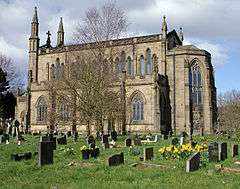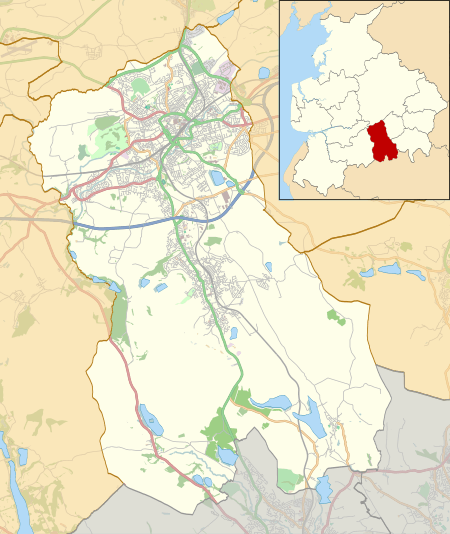Pleasington Priory
| Pleasington Priory | |
|---|---|
| Church of St Mary and St John Baptist | |
 Pleasington Priory from the southeast | |
 Pleasington Priory Location in Blackburn with Darwen | |
| Coordinates: 53°44′06″N 2°32′34″W / 53.7350°N 2.5429°W | |
| OS grid reference | SD 643,266 |
| Location | Pleasington, Lancashire |
| Country | England |
| Denomination | Roman Catholic |
| Architecture | |
| Heritage designation | Grade I |
| Designated | 24 November 1966 |
| Architect(s) | John Palmer |
| Architectural type | Church |
| Style | Gothic Revival |
| Groundbreaking | 1816 |
| Completed | 1819 |
| Construction cost | £23,000 |
| Specifications | |
| Materials | Ashlar, slate roofs |
| Administration | |
| Diocese | Salford |
Pleasington Priory, or the Church of St Mary and St John Baptist, is a Roman Catholic church in the village of Pleasington, Lancashire, England. It is recorded in the National Heritage List for England as a designated Grade I listed building.[1] The architectural historian Nikolaus Pevsner describes it as being "an astonishing church",[2] and the citation in the National Heritage List for England states it is an "exceptional form of Catholic chapel for the period before Emancipation".[1]
History
The church was built between 1816 and 1819 as a thank offering by John Francis Butler at a cost of £23,000 (£1.57 million as of 2016),[3] the architect being John Palmer and the sculptor Thomas Owen.[1]
Architecture
Exterior
The church is built in ashlar with slate roofs. It is a large, tall church with mixed Gothic styles. Its plan consists of a five-bay nave with a clerestory, north and south aisles, and a polygonal apse. Entry to the church is at the west through a three-order portal above which are three statues on corbels.[1] On the underside of the middle corbel is a bust of John Butler in military uniform.[2] Above the statue is a carved arch, then a small parapet and a large rose window, and a gable with an openwork parapet surmounted by a crocketed cross. At each side of the portal is an octagonal turret with a three-stage pinnacle. Outside the turrets are offices, each with a niche containing on one side the name of the architect and on the other the sculptor. The aisles have five five-light windows and are battlemented; the clerestory has triple lancet windows and an openwork parapet. The apse has tall five-light Perpendicular windows. On the south side is a priest's door.[1]
Interior
The ceiling is rib vaulted with carved bosses and there are four-bay arcades with dogtooth decoration. On each side of the altar is a carved relief, one showing the Beheading of St John, the other Mary Magdalene.[1]
External features
The churchyard contains the war graves of eight service personnel of World War I, and nine of World War II.[4]
See also
References
- 1 2 3 4 5 6 Historic England, "Roman Catholic Church of St Mary and St John the Baptist, Pleasington (1072419)", National Heritage List for England, retrieved 10 June 2012
- 1 2 Pevsner, Nikolaus (2002) [1969], North Lancashire, The Buildings of England, New Haven and London: Yale University Press, pp. 190–191, ISBN 0-300-09617-8
- ↑ UK CPI inflation numbers based on data available from Gregory Clark (2016), "The Annual RPI and Average Earnings for Britain, 1209 to Present (New Series)" MeasuringWorth.
- ↑ PLEASINGTON PRIORY (SS. MARY AND JOHN THE BAPTIST) ROMAN CATHOLIC CHURCHYARD, Commonwealth War Graves Commission, retrieved 18 February 2013
Further reading
- Hartwell, Clare; Pevsner, Nikolaus (2009) [1969], Lancashire: North, The Buildings of England, New Haven and London: Yale University Press, pp. 503–504, ISBN 978-0-300-12667-9